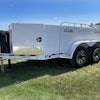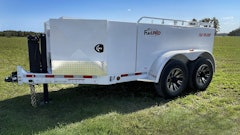The U.S. Environmental Protection Agency (EPA) and National Highway Traffic Safety Administration (NHTSA) jointly adopted a second round of standards for medium- and heavy-duty on-road vehicles that will cut carbon pollution and improve fuel efficiency. The Phase 2 program promotes a new generation of cleaner, more fuel efficient trucks, improving U.S. energy security and encouraging development of new cost-effective technologies starting and model year 2021 and being phased in completely with model year 2027.
Ambitious and Significant: The Phase 2 standards are expected to lower CO2 emissions by approximately 1.1 billion metric tons, save vehicle owners fuel costs of about $170 billion, and reduce oil consumption by up to 2 billion barrels over the lifetime of vehicles sold under the program. Phase 2 goes beyond the Phase 1 program (which goes into effect at the first of the year), with standards based not only on currently available technologies but emerging technologies that are not yet in widespread use.
Achievable and Flexible: The performance-based standards provide multiple technological pathways to compliance and were informed by a comprehensive assessment of advanced technologies and extensive stakeholder outreach. The standards phase in beginning in model year 2021 and culminate in standards for model year 2027. First-time GHG and fuel efficiency standards for trailers start in 2018 for EPA and in 2021 for NHTSA. The long phase in and incrementally stringent requirements give industry time to ensure products are reliable and durable, and provide long-term regulatory certainty.
Affordable and Cost-Effective: At every step of Phase 2, the standards include fuel savings that more than offset the costs and have favorable payback periods for truck owners. The typical buyer of a new long-haul truck in 2027 could recoup the extra cost of the technology in under two years through fuel savings. The program will also benefit consumers and businesses by reducing the costs for transporting goods. In total, the program will result in up to $230 billion in net benefits to society over the lifetime of vehicles sold under the program. This includes fuel savings, carbon reductions, health benefits, energy security benefits, along with travel benefits, and refueling benefits.
EPA and NHTSA worked closely with the California Air Resources Board to create a program that CARB can adopt, resulting in a truly national program that will allow manufacturers to continue to build a single fleet of vehicles and engines for the US market.
The final rules are based on extensive efforts to reflect the newest data and a lot of detailed stakeholder and public feedback, resulting in a program that:
- Achieves 10% more GHG reductions
- Has more robust compliance provisions such as more repeatable and accurate test procedures, enhanced enforcement audits, and protection against defeat devices
- Includes more stringent diesel engine standards and an improved vocational vehicle program with a regulatory structure better tailored to match the right technology for the job
- Maintains the structure and incremental phase-in of the proposed standards, allowing manufacturers to choose their own technology mix and giving them the lead time needed to ensure those technologies are reliable and durable
- Increases flexibilities to minimize impacts on small businesses
A statement on the new ruling from the American Trucking Associations said they were "cautiously optimistic" that the second round of commercial-truck efficiency standards would achieve agency targets without undue disruption to fleets and equipment manufacturers.
“While today’s fuel prices are more than 50% lower than those we experienced in 2008, fuel is still one of the top two operating expenses for most trucking companies,” said ATA President and CEO Chris Spear. “That’s why our industry has worked closely with both the Environmental Protection Agency and the National Highway Traffic Safety Administration over the past three and a half years to ensure these fuel-efficiency and greenhouse-gas standards took into account the wide diversity of equipment and operations across the trucking sector.”
Equipment manufacturer response to the greenhouse gas rule
CO2 and Fuel Consumption Standards
Phase 2 standards maintain the underlying regulatory structure developed in Phase 1, such as general categorization of medium- and heavy-duty vehicles and the separate engine standards. Under Phase 2, agencies are additionally adopting first-time CO2 and fuel efficiency standards for certain trailers used with heavy-duty combination tractors. Specifically, EPA’s CO2 emissions standards and NHTSA’s fuel consumption standards are tailored to each of four regulatory categories of heavy-duty vehicles:
- Combination Tractors
- Trailers Pulled by Combination Tractors
- Heavy-duty Pickup Trucks and Vans
- Vocational Vehicles (including all other heavy-duty vehicles such as buses, refuse trucks, and concrete mixers)
The program also includes separate standards for the engines that power combination tractors and vocational vehicles.
Combination Tractors
Class 7 and 8 combination tractors and their engines account for roughly 60% of total GHG emissions and fuel consumption from the heavy-duty sector. This is due to their large payloads and high number of vehicle miles traveled. Combination tractors play a major role in freight transport in the United States. The CO2 and fuel-consumption standards for combination tractors and engines start in model year 2021, increase incrementally in model year 2024, and phase in completely by model year 2027. The standards differ by vehicle weight class, roof height, and cab type (sleeper or day). The fully phased-in standards will achieve up to 25% lower CO2 emissions and fuel consumption compared to the Phase 1 standards.
Manufacturers will be able to meet the tractor standards through improvements in the engine, transmission, driveline, aerodynamic design, lower rolling resistance tires, extended idle reduction technologies, and other accessories of the tractor. Since engine technology delivers significant benefits a separate engine standard was developed to ensure that manufacturers implement engine technologies to deliver those benefits.
Trailers
Recognizing the trailer as an integral part of the tractor-trailer vehicle that significantly contributes to the emissions and fuel consumption of the tractor, the Phase 2 program includes standards for trailers used with heavy-duty combination tractors. The EPA’s standards begin in model year 2018. The NHTSA’s standards are voluntary from 2018 to 2020, with mandatory standards beginning in 2021. In general, the trailer standards apply only for box vans, flatbeds, tankers, and container chassis. The standards increase in stringency in model years 2021 and 2024, with final standards in model year 2027. The fully phased-in trailer standards achieve up to 9% lower CO2 emissions and fuel consumption compared to an average model year 2017 trailer. Technologies that could be used to meet the standards include: aerodynamic devices, lower rolling resistance tires, automatic tire inflation systems, and weight reduction.
Vocational Vehicles
Vocational vehicles consist of a wide variety of truck and bus types, including delivery trucks, refuse haulers, public utility trucks, transit, shuttle, and school buses. This segment also includes very specialized vehicles such as emergency vehicles, and cement and dump trucks. Vocational vehicles represent about 17% of total medium- and heavy-duty fuel consumption. The new CO2 and fuel consumption standards for vocational vehicles start in model year 2021, with increased stringency in model year 2024, and are fully phased in by 2027. The vocational vehicle standards are differentiated using vehicle weights and driving cycle, and chassis intended for emergency vehicles, cement mixers, coach buses, school buses, transit buses, refuse trucks, and motor homes may optionally use application-specific standards.
Once fully phased-in, Phase 2 standards reduce CO2 emissions and fuel consumption up to 24% compared to Phase 1. EPA and NHTSA project that the vocational vehicle standards could be met through improvements in the engine, transmission, driveline, lower rolling resistance tires, workday idle reduction technologies, weight reduction, and some application of hybrid technology.
Heavy-Duty Pickup Trucks and Vans
Heavy- and medium- duty pickup trucks and vans represent about 23% of fuel consumption and GHG emissions from the heavy- and medium-duty vehicle sector. The agencies are adopting CO2 emission and fuel consumption standards for heavy-duty pickups and vans that apply in largely the same manner as the Phase 1 standards. Under this approach, all manufacturers face the same standards, but the average emission and fuel consumption rates applicable to each manufacturer depend on the manufacturer’s sales mix, with higher-capacity vehicles (payload and towing) having less stringent targets. Standards for this segment take the form of a set of target standard curves, based on a “work factor” that, as in Phase 1, combines a vehicle’s payload, towing capabilities, and whether or not it has 4-wheel drive. The standards become 2.5% more stringent every year from model years 2021 to 2027, with fully phased-in reductions in CO2 emissions and fuel consumption of about 16% beyond Phase 1.
The agencies believe most manufacturers will choose to meet the performance standards through increased use of the same technologies already being used to meet the 2014–2018 standards. These technologies include improvements in engines, transmissions, and lower rolling resistance tires. Under Phase 2, the agencies expect newer, advanced technologies such as engine stop/start and powertrain hybridization will also become available in this segment of the market. These newer technologies are not mandated but some manufacturers may choose to use them to meet the standard.
Engine Standards
As with the Phase 1 program, EPA and NHTSA are adopting separate standards and test cycles for tractor engines, vocational diesel engines, and vocational gasoline engines. For diesel engines, the standards begin in model year 2021 and phase in to model year 2027, with interim standards in model year 2024. The agencies are also adopting a revised test-cycle weighting for tractor engines to better reflect actual in-use operation. The final diesel engine standards will reduce CO2 emissions and fuel consumption by up to 5% for tractor engines and up to 4% for vocational engines compared to Phase 1.
Technologies that could be used to meet the standards include combustion optimization, improved air handling, reduced friction within the engine, improved emissions after-treatment technologies and waste heat recovery.
Program Flexibilities
This rule includes averaging, banking, and trading (ABT) compliance provisions for the engine and vehicle standards in this program. These provisions allow manufacturers to trade credits, bank credits for future years, and average credits, which in turn allows manufacturers to certify engines or vehicles that do not perform up to the standard and offset them with engines or vehicles that perform better than the standard. With these ABT provisions, manufacturers can balance market fluctuations impacting their sales volumes and projected compliance plans.
The ABT program was established under Phase 1, and EPA and NHTSA are continuing it with some revisions. The ABT flexibilities are designed to help increase the rate at which new technologies can be implemented, reduce the cost of compliance, and address potential lead time challenges in meeting the standards.
As with similar flexibilities in the light-duty Corporate Average Fuel Economy program and other mobile source pollution control programs, the Phase 2 ABT program includes rigorous compliance provisions to ensure that the energy savings and environmental goals of the program are met and the standards are applied equitably among all manufacturers.
EPA and NHTSA are not adopting a full ABT program for the trailer standards because the nature of the industry makes it a challenge for trailer manufacturers to benefit from this type of program. Instead, the agencies are finalizing an averaging program available in MY 2027 for manufacturers of dry and refrigerated box vans.
Broadly, these provisions provide additional lead time for small business manufacturers, as well as simplified testing and compliance requirements. EPA and NHTSA are also finalizing exemptions for nonbox specialty trailer types that remove or reduce the burden for many small businesses.
Finally, the agencies are including reduced standards and/or simplified compliance requirements for manufacturers of specialized vehicle chassis, such as those intended for emergency vehicles, cement mixers, coach buses, school buses, transit buses, refuse trucks, and motor homes.
Read the final rule, regulations and related documents on EPA’s web site





![[VIDEO] Truck Greenhouse Gas Rules to Boost Fuel Efficiency 24%](https://img.forconstructionpros.com/files/base/acbm/fcp/image/2016/08/default.57c6dba758fbe.png?auto=format%2Ccompress&fit=crop&h=167&q=70&w=250)












